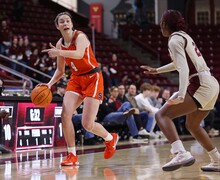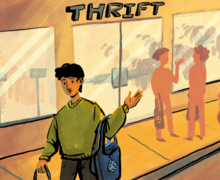‘I’ve Learned to Hold Myself Softly’ exhibit reflects on identity in changing cities
Lars Jendruschewitz | Photo Editor;
Cali M. Banks' exhibit is currently on display at the Everson Museum of Art. Her work consists of portraits and still life pieces.
Get the latest Syracuse news delivered right to your inbox.
Subscribe to our newsletter here.
In fall 2022, local lens-based artist Cali M. Banks visited her hometown of Syracuse. While in the city, she ventured north to Mattydale to photograph a familiar roller skating rink, Sports-O-Rama. Upon her arrival, however, she discovered a vacant plot and an abandoned neighboring Pizza Hut she’d frequented in her childhood.
“The sign is completely gone and there are vines growing through it,” Banks said. “I find a bit of beauty in some things that are overgrown. But there’s also some sadness for things that were so important to me as a kid that are completely unkempt.”
The graffiti-covered, shattered window structure became part of the catalyst for her 31-part documentary project, “I’ve Learned to Hold Myself Softly.” Banks’ exhibit examines her identity and return to Syracuse. The photographs are on display at the Everson Museum of Art until Dec. 27.
Banks, of Munsee Lenape and Scottish heritage, was born and raised by her mother near the border of Syracuse’s Northside neighborhood. Banks became the caretaker of their home, as her mother lived with a lifelong disability from an injury she sustained before Banks’ birth. In the early years of her youth, she delved into photography.
“My mom used to get these 35-millimeter disposable cameras, and I, as a kid, at 5, 6, to maybe 8 years old, would just take pictures of everything,” Banks said. “She would have all of the film developed and then put them in little albums for me.”
Banks attended Allegheny College, where she majored in Art & Technology and took her first formal photography class in her freshman year. Her professor, who she described as young, relatable and helpful, inspired Banks to take more photography courses. She later earned a Master of Fine Arts degree in Interdisciplinary Media Arts Practices from the University of Colorado Boulder.
For some time, Banks worked in Brooklyn as a partnerships coordinator for a filmmaking organization and a teaching artist for filmmaking. While her mother now lives in North Carolina, Banks still has family members in the Syracuse area. But the “real draw” back to her home was a job at Light Work, a nonprofit photography center at Syracuse University.
“I saw this position open and I said when I was leaving for college, the only way I would come back to Syracuse is if a job opened at either Light Work or Syracuse University,” Banks said.

Courtesy of Cali M. Banks
A multimedia photograph in Banks’ collection depicts a Columbus Avenue street sign located in Syracuse. Featuring white beads and gold leafing, the image represents Banks’ Indigenous identity.
Currently, Banks works as Light Works’ communications coordinator and teaches Film and Media Arts in the College of Visual and Performing Arts at SU. Her college and professional experiences leading up to her return made her re-evaluate aspects of her hometown.
J Coley, a postdoctoral research fellow in the Lender Center for Social Justice at SU, provides insight into changing cities like Syracuse. Coley is working on a book project that uses Buffalo as a case study of the long-term impacts of displacement, gentrification and racist public planning decisions on Black communities.
Originally from Rochester, Coley has experienced parts of upstate, western and central New York.
“These cities are alike in the sense that they were Rust Belt cities that a lot of people moved to before the 1950s in hopes to get opportunities for work and things like that,” Coley said. “But once industrialization began in 1950, a lot of people ended up moving, so Syracuse is considered a shrinking city.”
New York City often shadows cities like Syracuse and Buffalo, Coley said, so locals often don’t get the investments and finances that help these communities.
Banks’ work provides an artistic perspective to Coley’s research. She said “I’ve Learned to Hold Myself Softly” is a survey of how Syracuse and her coming-of-age years are abandoned, neglected or gentrified. At the same time, Banks gives herself grace with her own identity.
In graduate school, Banks developed a close friendship with her peer, Román Anaya, who gave her unconditional care. She confided in him, often visiting his home where he and his husband supported her.
“There was one time where I was sharing a lot of different situations I went through and he looked at me and was like, ‘You don’t have to be like this all the time. You don’t have to be so tough all the time. You can show your emotion in different ways. It’s okay to open up and be soft with yourself,’” Banks said. “Nobody had ever really told me that before.”
Two weeks before their M.F.A. graduation, Anaya unexpectedly died. “I’ve Learned to Hold Myself Softly” is Banks’ way of paying homage to her friend. Yet, she noted the exhibit’s title has another meaning.
During her time in Brooklyn, she worked with an assistant and realized their lives growing up were similar. The assistant would always apologize for her sensitivity but Banks told her that her vulnerability is admirable.
“The things that made her soft left me this hard shell on the outside,” Banks said. “I always appreciated her soft approach to the world.”
Throughout college, Banks created more identity-based art. She said she is white presenting, but her Indigenous mother exposed her to a culture and traditions. Still, she said she lives in a liminal space of privilege because of her appearance but deeply identifies with her other side.
There's a lot of sadness that relates to this demolishing or abandoning of places, but there's also still a lot of nostalgia and memory.Cali M. Banks, Syracuse-born artist
In the exhibit, Banks features identifiers that bring attention to her Indigenous identity. The first inclusions are roses, a theme that stands out in other works she has created.
“My mom created this ritual where if we are having a hard time or need some sort of good luck charm and we see a rose by chance, we would think it was a sign from ancestors,” Banks said. “So she gave us different colors to represent different family members.”
For example, between Banks and her mother, a pink rose represents their bond while a red rose symbolizes Banks’ maternal grandparents.
The second noticeable inclusion is beadwork. Of the exhibit’s 31 total photographs, 27 of them are hand-beaded.
Banks said the beadwork is accomplished with a traditional two-needle Indigenous technique. In this way, she ties in her culture, even being intentional with the beads’ colors — black, white and red — each a color of the Lenape tribe. Banks said the colors can also have twofold meanings.
Red, she said, can mean passion or violence. Black can connote strength or aggression. Lastly, she described white as a color to represent living your truth.
Banks also adds gold materials, like leafing, to pinpoint value in some of the photographs. In finalizing each photograph, she includes one blue bead. Historically, in traditional Indigenous beadwork, she said, sometimes there would be an off-skew bead or a bead of a different color which acted as the artist’s signature. The blue bead also holds value for Banks as it recognizes her maternal grandfather’s favorite color.
“Cali’s show is just incredible,” said Koz, lab coordinator at Light Work. “She really has her hand sort of in the work with the way that she uses Polaroids through emulsion lift. And then how she also hand-beads her work, which is just really incredible and exquisite to see up close in person.”
Like Banks, Koz grew up in Syracuse and the two attended the same high school. Koz is a landscape and self-portraiture photographer. She and Banks practice artistic techniques unique to each of them, but are similar in that they keep their work private until it’s ready to go out into the world.
With “I’ve Learned to Hold Myself Softly,” Banks hopes that viewers can place themselves inside the work and contemplate their upbringing and relationship with Syracuse. She said there are a lot of cities that could resemble what is pictured in these images.
“There’s still a bit of beauty and hope to the city that’s left,” Banks said. “Sure, there’s a lot of sadness that relates to this demolishing or abandoning of places, but there’s also still a lot of nostalgia and memory.”
Published on September 5, 2024 at 1:07 am






